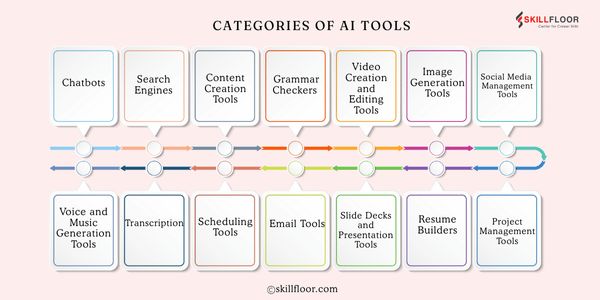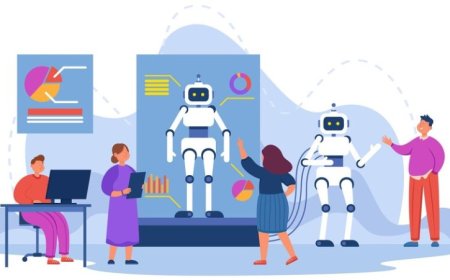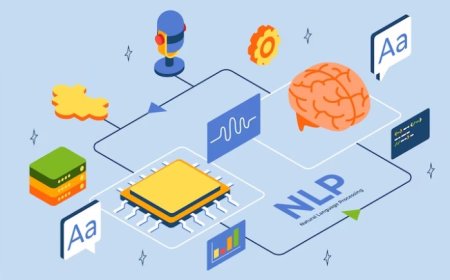Artificial Intelligence Tools
The power of AI tools to boost productivity, automate tasks, and drive innovation in your business. Explore AI solutions for every industry.

As someone who has spent a lot of time exploring new technologies, I know that artificial intelligence (AI) tools have completely changed how we solve problems, make decisions, and innovate. AI isn’t just a fancy term—it refers to a collection of tools and technologies that are transforming industries and unlocking new opportunities I never thought possible a few years ago.
What Are Artificial Intelligence Tools?
To keep it simple: AI tools are software programs powered by data and algorithms that mimic human intelligence to perform tasks like learning, problem-solving, reasoning, and even creativity. These tools are not only used for everyday tasks but are now helping businesses and industries make better decisions and drive innovation.
AI tools are everywhere today. They help analyze data, offer insights, automate processes, and even chat with users, like what we’re doing right now. They’re flexible and can be adapted for anyone—from individuals to businesses and large organizations.
Sure, here’s an updated list incorporating the tools you mentioned, along with brief descriptions of each one:
Categories of AI Tools
1. Chatbots
AI powers chatbots to handle conversations, answer queries, and assist with customer service tasks.
-
ChatGPT: An AI language model developed by OpenAI that can generate text, assist with problem-solving, and hold conversations across various topics.
-
Claude: An AI model from Anthropic designed to converse naturally, with a focus on safety and user-friendly responses.
-
Meta AI: A family of AI models by Meta (formerly Facebook), which includes chatbots designed for customer interaction and communication.
-
Zapier Agents: Automates tasks across apps and services, with a chatbot-like interface for triggering workflows, such as sending messages or creating tasks.
2. Search Engines
AI-powered search engines offer advanced features such as context-aware search results and smarter responses.
-
Perplexity: A search engine that leverages AI to give detailed, context-sensitive answers to queries, based on information from diverse sources.
-
Google AI Overviews: Google’s AI-driven features improve the search experience, from enhancing search results to understanding user intent better.
-
Arc Search: A web search engine with AI-based features designed to deliver smarter and more refined search results.
3. Content Creation Tools
These AI tools assist with writing, editing, and generating content, including blogs, articles, and social media posts.
-
Jasper: A popular AI content creation tool that helps generate blog posts, marketing copy, social media content, and more.
-
Anyword: An AI tool that generates optimized marketing copy, providing real-time data on how well the text will perform.
-
Writer: A content creation tool that helps produce high-quality content quickly, with features like AI-assisted writing and content ideas.
4. Grammar Checkers and Paraphrasing Tools
These tools use AI to check grammar, suggest improvements, and rephrase sentences for clarity and style.
-
Grammarly: An AI-powered writing assistant that corrects grammar mistakes, enhances style and suggests better word choices.
- Editpad: A simple-to-use AI-powered paraphrasing tool that helps you easily rephrase content into an improved version. It refines tone, clarifies sentences, and improves readability.
-
-
Wordtune: A rewording tool that helps rephrase sentences, improving clarity and tone while maintaining original meaning.
-
ProWritingAid: A comprehensive writing assistant that provides grammar checks, style suggestions, and reports on readability.
5. Video Creation and Editing Tools
These AI tools help create, edit, and enhance videos for content creators and businesses.
-
Runway: A video creation platform with AI tools for editing, object tracking, and generating new video content.
-
Descript: A video and podcast editing tool that uses AI for transcription and easy editing via text, along with features like overdubbing.
-
Wondershare Filmora: A video editing software that integrates AI to simplify editing tasks like background removal, motion tracking, and effects.
6. Image Generation Tools
These tools use AI to create images from textual descriptions, enabling creativity and content generation.
-
DALL·E 3: An image-generation tool by OpenAI that creates images from text prompts, with improvements in rendering more accurate, detailed visuals.
-
Midjourney: A generative AI tool that creates stunning and artistic images based on text prompts, often used by artists and designers.
-
Ideogram: A tool that specializes in AI-generated graphics and illustrations from textual input, aimed at enhancing visual content creation.
7. Social Media Management Tools
AI-based platforms help businesses and individuals manage their social media presence more effectively, with content scheduling, insights, and engagement.
-
FeedHive: A social media management tool powered by AI that helps users schedule posts, track engagement, and optimize their content.
-
Vista Social: An AI-driven social media management tool that provides insights and analytics to improve content strategy and user engagement.
-
Buffer: A widely used tool for managing and scheduling social media posts, with AI-powered features for content recommendations and performance analytics.
8. Voice and Music Generation Tools
AI can create realistic voices and generate music, providing tools for entertainment, media, and marketing.
-
ElevenLabs: A voice synthesis platform that creates realistic and lifelike voices for content creators, virtual assistants, and other applications.
-
Suno: A tool that uses AI to generate voices and sounds, often used in podcasts, video production, and virtual assistant development.
-
AIVA: An AI music composition tool that creates original compositions across genres, used by musicians, content creators, and filmmakers.
9. Task and Project Management Tools
AI tools are designed to help with task delegation, project tracking, and optimizing workflows in teams.
-
Asana: A project management tool that uses AI to suggest task assignments, track progress, and streamline communication within teams.
-
Any.do: A productivity tool that integrates AI to prioritize tasks, set reminders, and manage daily activities across devices.
-
BeeDone: A task management platform that incorporates AI to streamline personal and team workflows and offers intelligent suggestions for time management.
10. Transcription and Meeting Assistants
AI-powered tools that transcribe meetings, summarize discussions and offer insights.
-
Fireflies: An AI-powered transcription tool that records, transcribes, and analyzes meetings to extract key insights and action items.
-
Avoma: A meeting assistant that uses AI to automatically transcribe, summarize, and analyze meetings for more efficient follow-ups.
-
tl;dv: A tool designed to transcribe video and audio content, allowing users to search for key moments and easily share highlights from meetings.

11. Scheduling Tools
AI tools that help schedule meetings, optimize time management, and reduce scheduling conflicts.
-
Reclaim: An AI-powered personal assistant that automatically schedules meetings, tasks, and optimizes calendar management.
-
Clockwise: An AI scheduling assistant that helps businesses optimize meeting times and reduce conflicts for teams.
-
Motion: An AI-driven tool that schedules and prioritizes tasks based on the user’s preferences, habits, and calendar.
12. Email Tools
AI-powered tools are designed to help manage emails more effectively, from writing drafts to optimizing inboxes.
-
Shortwave: An email management platform that leverages AI to categorize, prioritize, and handle incoming emails for improved productivity.
-
Microsoft Copilot Pro for Outlook: A smart assistant for Outlook that uses AI to help draft responses, categorize emails, and automate inbox management.
-
Gemini for Gmail: An AI-based email assistant that helps manage Gmail inboxes, draft responses, and automate email processes.
13. Slide Decks and Presentation Tools
These tools assist in creating professional slide decks with AI-powered design recommendations and content suggestions.
-
Tome: A modern storytelling tool that helps users create interactive presentations using AI-generated content.
-
Beautiful.ai: An AI-based presentation tool that designs slides with smart layouts and content suggestions to create visually appealing presentations.
-
Slidesgo: A platform that offers free and customizable Google Slides and PowerPoint templates, with AI suggestions for design and content.
14. Resume Builders
AI tools that help users create professional resumes, optimizing the document for job applications.
-
Teal: A resume builder that uses AI to offer personalized resume feedback and suggestions, helping users land their ideal jobs.
-
Enhancv: A tool that helps job seekers create visually appealing and highly customizable resumes, using AI to highlight skills and achievements.
-
Kickresume: An AI-powered resume builder that helps create resumes and cover letters, with real-time feedback and optimizations.
AI Tools for Businesses
AI tools can help businesses in many areas:
-
Automate repetitive tasks: AI can automate tasks like data entry, customer service responses, and content generation, freeing up employees for more critical work.
-
Increase efficiency and productivity: With smart tools managing day-to-day tasks, businesses can operate more efficiently and effectively.
-
Streamline workflows: AI streamlines business processes by removing bottlenecks and ensuring smoother collaboration between departments.
-
Provide insights through advanced analytics: AI-powered analytics tools help businesses make data-driven decisions by providing deeper insights into business performance and market trends.
-
Make better decisions: With AI tools offering predictive analytics, businesses can make informed decisions faster, optimizing growth and profitability.
With the rapid development of AI tools, businesses and individuals now have access to powerful platforms that can improve productivity, creativity, and decision-making. These tools continue to evolve and expand, making it increasingly easier to integrate AI into everyday tasks and workflows.
Applications of AI Tools
One of the best parts about AI tools is their wide range of applications. Here’s how AI is changing different industries:
1. Marketing
From personalizing email campaigns to analyzing consumer behavior, AI has completely changed marketing. Tools like SEMrush and Ahrefs help businesses track keywords and predict trends, making campaigns more efficient. I’ve also used AI content generation tools to create personalized marketing messages for different audiences.
2. Healthcare
AI is helping doctors diagnose diseases faster and more accurately. For example, IBM Watson Health helps analyze medical data and assists in diagnosing various health conditions. AI is also being used to track patients and improve drug discovery.
3. Finance
AI tools are essential in finance for managing risks, detecting fraud, and making investment decisions. Kabbage, for example, uses AI to assess a company’s creditworthiness. AlphaSense helps finance professionals by offering AI-powered insights into market trends and financial reports.
4. Education
AI is revolutionizing the way people learn. Tools like Duolingo help users learn languages with AI-driven personalization, while platforms like Skillfloor offer AI-powered recommendations to help students find the right courses.
5. Customer Support
AI is also improving customer service. Chatbots like Zendesk AI can answer customer questions instantly, providing quicker responses and better service, which leads to happier customers.
Benefits of AI Tools
I’ve found that AI tools come with many advantages:
-
Increased Efficiency: AI tools automate repetitive tasks, letting you focus on more important tasks.
-
Cost Savings: Businesses can save money by automating processes and reducing the need for manual labor.
-
Better Decision-Making: With AI-powered analytics, businesses can make better, data-driven decisions.
-
Personalization: AI helps businesses provide personalized experiences to customers, whether it’s through marketing, recommendations, or customer support.
-
Scalability: AI tools grow with your needs, making them suitable for businesses of all sizes.
Challenges and Limitations
While AI tools offer many benefits, they do come with their challenges. One major issue is protecting the data that AI relies on. Because AI tools process so much data, there’s always the risk of data breaches or misuse.
Cost can also be a barrier. Some of the more advanced AI tools can be expensive, which might make it hard for smaller businesses or individuals to access them.
Lastly, there are ethical concerns around AI, such as bias in algorithms and the potential for AI to replace human jobs. These are important topics that still need attention.
Developing Patterns in AI Tools
The world of AI tools is constantly changing, and I’ve been watching some exciting trends:
-
Generative AI: Tools like DALL-E and MidJourney are opening up new creative possibilities by generating art, images, and more.
-
AI for Small Businesses: More affordable AI tools are now available, allowing small businesses to compete with larger companies.
-
Real-Time AI: Tools that provide real-time data analysis are becoming increasingly popular.
These trends show that AI tools are only going to become more powerful and accessible in the future.
How to Choose the Right AI Tool
If you’re feeling overwhelmed by the many options out there, here’s how I go about choosing the right AI tool:
-
Define Your Goals: First, figure out what you need. Are you looking for automation, analytics, or creative tools?
-
Ease of Use: Make sure the tool is easy to use and fits well with your workflow.
-
Consider Cost: AI tools can be expensive, so choose one that fits within your budget and offers good value.
-
Check Reviews: Reading reviews and case studies from others who’ve used the tool can help you make an informed decision.
By following these steps, I’ve been able to find tools that truly add value to my work.
Future of AI Tools
Looking ahead, I see AI tools becoming an even bigger part of our lives. They’ll continue to improve, become more accessible, and change how we work in ways we can’t even imagine yet. Industries will continue to innovate, and businesses will rely on AI to stay competitive.
While there are still challenges around privacy and ethics, the benefits of AI tools are undeniable.
My journey with AI tools has been incredibly rewarding. These tools have helped me save time, make better decisions, and unlock new opportunities in ways I never thought possible.
If you haven’t explored AI tools yet, now’s the time to start. Whether you’re a business owner, student, or just someone interested in technology, there’s an AI tool out there that can make your life easier and more efficient.
Here’s a list of some of the tools I mentioned in the blog:
-
ChatGPT, Grammarly, IBM Watson, OpenCV
-
UiPath, Zapier, Blue Prism
-
DALL-E, MidJourney, Jasper AI
-
Tableau, Power BI, Looker
The future of AI tools is bright, and I’m excited to see how they continue to evolve. Let’s embrace the potential of AI and use these tools to create a better, more efficient future.




























































